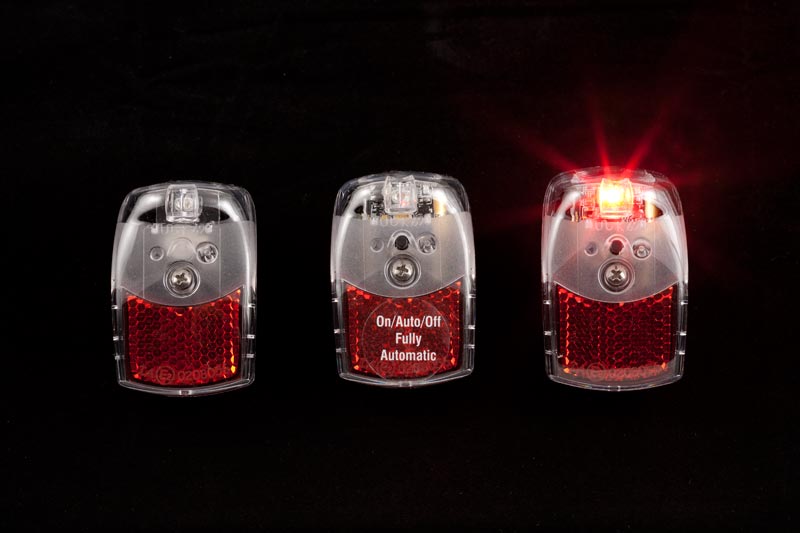I recently built up a new city bike for my wife. When it came to lighting, I wanted an inexpensive but effective battery setup. I had used Spanninga lights before, and liked them (Spanninga is a Dutch company, and manufactures the lights for the majority of Dutch bikes… which is to say, a lot of bikes). When I saw that Spanninga had introduced a new fender-mount taillight with a neat auto mode, I thought I’d give it a try. I thought it would look the part on my wife’s neo-classic mixte, and it was very reasonably priced ( from Peter White Cycles). I was also curious to test the auto mode, and see if the light could truly be used in a “set and forget” way.
Installation
The light is very lightweight, and would work well on just about any properly mounted plastic or aluminum fender without inducing fender instability or wobble problems. It is designed strictly for fender mounting, with a curved shell to match the curvature of a fender. It requires two 5mm holes to be drilled into the fender, 20mm apart vertically. One hole serves as a positioner, accepting a molded plastic tab on the back of the taillight housing, while the other receives a 5mm threaded stud. A 5mm nut and star washer are included. Two Duracell AAA batteries are also included.
Use and impressions
The small push-button switch toggles between “on”, “auto” and “off” positions. The button is also shrouded by the molded taillight shell to protect it from accidentally being switched when bumped, so any button action has to be intentional. The circuitry provides visual feedback when you select “auto” or “off” by blinking twice or once, respectively. Being a European light, there is no flashing mode, only constant. The LED is fairly bright, but not as bright as some of the super-bright lights out there… It also has a somewhat narrow beam, and is brightest and most focused when viewed directly from behind, although it visible from the side. 50% of the time that the bike is ridden by my wife, I am riding directly behind it, so I’ve developed a fairly good sense for what type of light conditions trigger the light to come on when in auto mode. After leaving the light in auto mode for a month, it seems like a fairly intelligent setting. The auto mode works by using two sensors: a light sensor and a motion sensor. Both sensors must be triggered for the light to come on: the bike must be in motion (or jolted), AND the ambient light must be fairly dim, for the light to switch on. I’ve found that the light sensor reliably triggers the light on at dusk, or even in midday ambient light if we ride under a shaded bridge or underpass. It seems to be calibrated to come on more often than you would need it to (such as early dusk, or during a rainstorm), which is a good thing, IMO. The motion sensor is on a timer and seems to work synergistically with the light sensor: if we come to a stoplight in low light conditions, the light stays on the entire duration that we’re stopped. (I haven’t timed it, but it’s claimed to be four minutes, which seems long enough). The light sensor does not appear to be on a timer: if we ride under a dark bridge or tunnel, the light switches on immediately, then switches back off within a few seconds of exiting back into direct daylight. If your bike is routinely stored in a dimly lit area and frequently bumped into (such as in an apartment building foyer), then the auto mode might not work well– the light may switch on frequently enough to drain the batteries prematurely. In that case, no problem– just use it like any other battery light by manually switching it on and off.
After about 5-6 weeks of nearly daily use (but admittedly not much night riding), the two originally supplied AAA batteries are still going strong. When it comes time to replace them, the only tool needed is a phillips-head screwdriver to remove the lens, which is held on to the rest of the light by a single screw. Although some battery lights use a snap-on cover and don’t require any tools to replace the batteries, I actually prefer this setup because there’s no chance that the lens can pop off if banged into– something that’s happened with other lights I’ve owned.
All in all, it’s a nice little light: lightweight, inexpensive, easy to use, good looking (IMHO), with an intelligently programmed and reliable auto mode. I like it enough that I just bought two more for two of my other fender-clad bikes!


